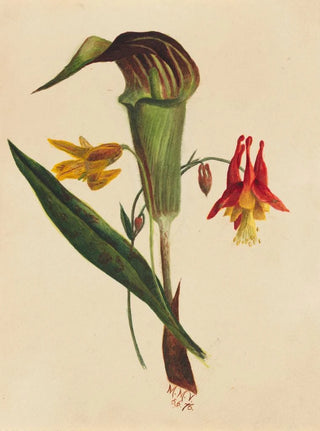Art print | Jack in the pulpit - Mary Vaux Walcott


View from behind

Frame (optional)
Jack dans la chaire - Mary Vaux Walcott – Introduction captivante
The artwork "Jack dans la chaire" by Mary Vaux Walcott presents itself as an open window into a universe where nature and art meet with striking delicacy. This piece, imbued with the beauty of American landscapes, evokes a suspended moment, a contemplative pause amidst lush greenery. By observing this artwork, the viewer is immediately transported to a space where light plays with shapes, revealing the magic of details that often escape our daily gaze. The artist manages to capture the very essence of wildlife, while infusing it with a touch of poetry and serenity.
Style and uniqueness of the artwork
Mary Vaux Walcott's style is distinguished by her ability to combine realism and impressionism. Each brushstroke seems to be an ode to nature, highlighting the richness of colors and the diversity of textures. In "Jack dans la chaire," shades of green and blue blend harmoniously, creating a lively tableau that evokes the freshness of a morning in the forest. The composition is carefully balanced, allowing elements to unfold without ever appearing cluttered. The depiction of the central character, Jack, illuminated by light filtering through the foliage, demonstrates exceptional mastery of light and shadow. This artwork does not merely depict a moment; it invites an immersive experience, where each glance reveals a new facet of natural beauty.
The artist and her influence
Mary Vaux Walcott, botanist and artist, skillfully combined her two passions to create works that transcend the simple artistic frame. Her commitment to nature and her desire to preserve it are reflected in each of her creations. As a pioneer in the field of botanical art, she not only contributed to raising awareness about biodiversity but also inspired many generations of artists to explore themes of nature and conservation. Her influence extends far beyond her time, resonating even today in the work of contemporary artists seeking to capture the beauty of our planet. Walcott transformed her love for nature into a visual language that speaks to everyone, transcending barriers

Matte finish

View from behind

Frame (optional)
Jack dans la chaire - Mary Vaux Walcott – Introduction captivante
The artwork "Jack dans la chaire" by Mary Vaux Walcott presents itself as an open window into a universe where nature and art meet with striking delicacy. This piece, imbued with the beauty of American landscapes, evokes a suspended moment, a contemplative pause amidst lush greenery. By observing this artwork, the viewer is immediately transported to a space where light plays with shapes, revealing the magic of details that often escape our daily gaze. The artist manages to capture the very essence of wildlife, while infusing it with a touch of poetry and serenity.
Style and uniqueness of the artwork
Mary Vaux Walcott's style is distinguished by her ability to combine realism and impressionism. Each brushstroke seems to be an ode to nature, highlighting the richness of colors and the diversity of textures. In "Jack dans la chaire," shades of green and blue blend harmoniously, creating a lively tableau that evokes the freshness of a morning in the forest. The composition is carefully balanced, allowing elements to unfold without ever appearing cluttered. The depiction of the central character, Jack, illuminated by light filtering through the foliage, demonstrates exceptional mastery of light and shadow. This artwork does not merely depict a moment; it invites an immersive experience, where each glance reveals a new facet of natural beauty.
The artist and her influence
Mary Vaux Walcott, botanist and artist, skillfully combined her two passions to create works that transcend the simple artistic frame. Her commitment to nature and her desire to preserve it are reflected in each of her creations. As a pioneer in the field of botanical art, she not only contributed to raising awareness about biodiversity but also inspired many generations of artists to explore themes of nature and conservation. Her influence extends far beyond her time, resonating even today in the work of contemporary artists seeking to capture the beauty of our planet. Walcott transformed her love for nature into a visual language that speaks to everyone, transcending barriers






